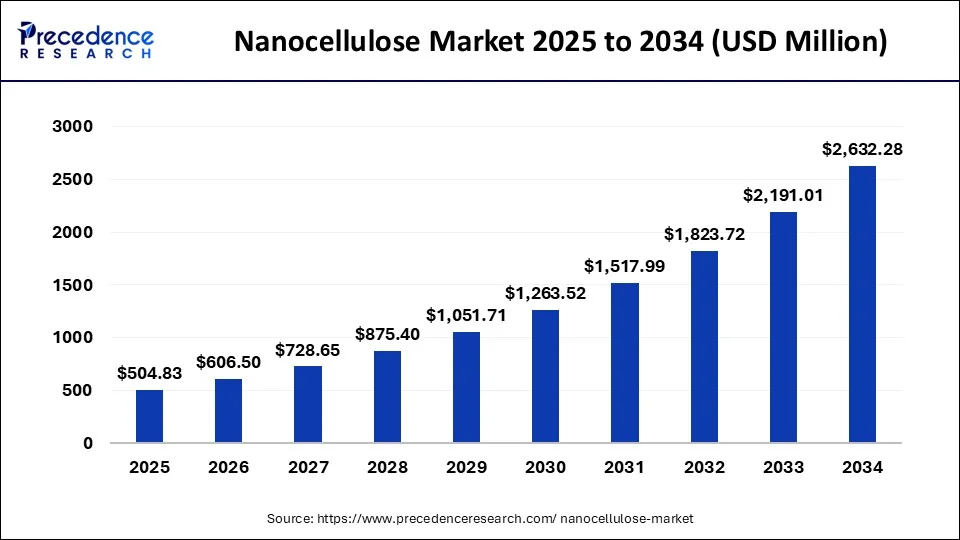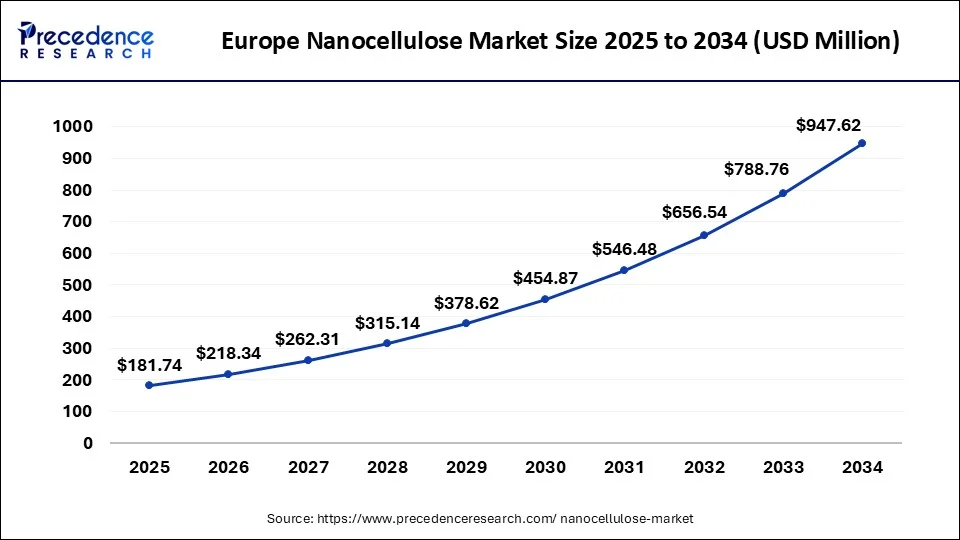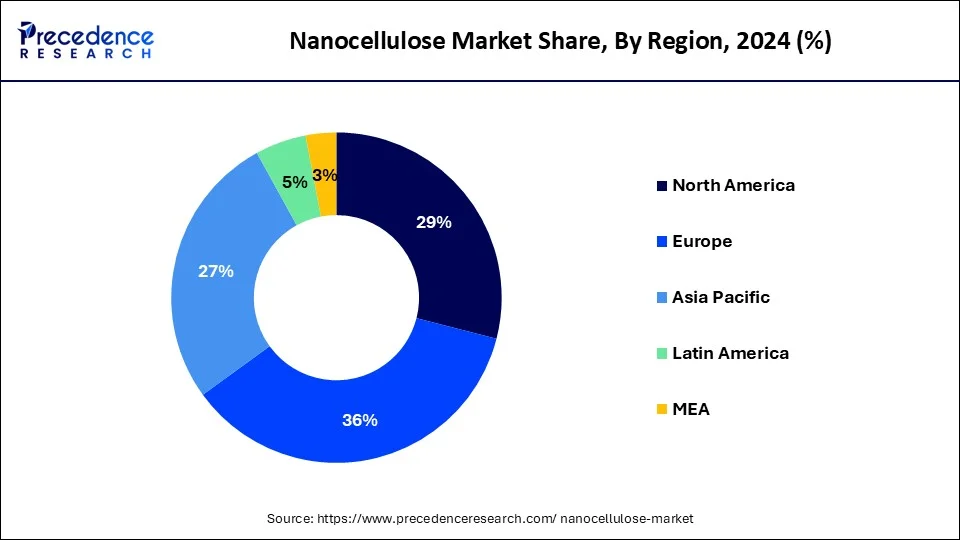List of Contents
Nanocellulose Market Size and Forecast 2025 to 2034
The global nanocellulose market size was estimated at USD 504.83 million in 2024, and is projected to hit around USD 606.5 billion by 2025, and is anticipated to reach around USD 3,162.42 million by 2034, expanding at a CAGR of 20.14% from 2025 to 2034.

Nanocellulose Market Key Takeaways
- In terms of revenue, the market is valued at $606.5 billion in 2025.
- It is projected to reach $3162.42 billion by 2034.
- The market is expected to grow at a CAGR of 2% from 2025 to 2034.
- The Europe region has captured the highest revenue share of around 35.2% in 2024.
- The North America market is expected to hit the second-largest revenue holder in 2024.
- By type, the CNF type segment has accounted revenue share of around 54.1% in 2024.
- By application, the pulp & paper board segment held a 30.6% revenue share in 2024.
Europe Nanocellulose Market Size and Growth 2025 to 2034
The Europe nanocellulose market size is estimated at USD 218.34 million in 2025 and is expected to be worth around USD 1,154.28 million by 2034, rising at a CAGR of 20.29% from 2025 to 2034.

In terms of regions, the Europe is expected to dominate the market during the projected period owing to the growing demand for paper and pulp applications and huge capital investment in R&D of Nanocellulose substances in this region. In Europe, product innovation projects have been financed and supported by both the commercial and public sectors, and these influencing factors are expected to boost the global Nanocellulose market growth during the forecast period.

The Asia Pacific market is anticipated to expand at a rapid pace during the forecast period owing to the growth of the automotive, composites, and packaging industries. Moreover, there is a gradual increase in the middle-class population and a rising number of newly purchased lightweight cars. In this region, there are cheap sources of raw materials, labor, and low manufacturing costs are the most influencing drivers for the region's growth during the forecast period. However, North America is expected to experience a moderate increase in the Nanocellulose market owing to the high potential for consumption and expanding production capabilities.
North America is observed to grow at a considerable growth rate in the upcoming  period, fueled by a rising need for sustainable and high-performance materials across multiple sectors. The region benefits from a strong research foundation and the presence of leading market players, which are driving innovation and the commercialization of nanocellulose products. Applications in industries such as packaging, biomedical, and automotive are on the rise, supported by governmental initiatives that advocate for environmentally friendly materials. Partnerships between academic institutions and industry participants are accelerating the advancement of sophisticated nanocellulose applications, establishing North America as a crucial player in the global nanocellulose market.
Canada is positioning itself as a frontrunner in the nanocellulose market, utilizing its rich forest resources coupled with advanced research skills. Leading organizations such as FPInnovations and companies like CelluForce are pioneers in crafting innovative applications of nanocellulose. The Canadian government's backing of sustainable technologies and investments in green infrastructure are driving the integration of nanocellulose in sectors such as packaging, construction, and biomedicine, bolstering Canada's status in the international market.
Market Overview
Nanocellulose is nanostructured cellulose. It can be used to create Nanocellulose fibrils from wood-based materials. Nanocellulose is the elementary building block of natural cellulose.
Nanocellulose is light in weight and of solid material. It consists of the property of certain kinds of gels or fluids that are generally viscous in normal conditions. It is extensively used in a wide range of applications from food, pharmaceuticals, medical industries, and children's toys. It has the capability to replace several petrochemical-based products.
It occurs naturally and the material is isolated from the cellulose of wood, various plants, bacteria or algae. Nanocellulose can also be separated from natural fiber through the method of acid hydrolysis resulting in hard nanoparticles. Highly crystalline nanocellulose is made from various cellulosic waste biomass, such as microorganisms, crops, and organic waste. It includes the properties such as high tensile strength and biocompatibility which appeals to an extensive range of markets, from construction to medical to aircraft. Nanocellulose is commonly classified as cellulose nanofibers (CNF), cellulose Nanocrystals (CNC), and bacterial Nanocellulose (BNC). These are being generated in various ways. These three major varieties differ in physio-chemical properties from size to size. Production of commercial Nanocellulose is cellulose nanofibers synthesized on a significant scale in Japan.
Nanocellulose is being used in several applications such as biomedical products, catalytic substrates, electronic component templates, electrochemically active polymer, composite, packaging, cosmetics, ultra-capacitor, pharmaceuticals, and batteries. The most crucial application is it is being used as an additive to produce a strong paper. The growing demand for nanocellulose material is due to its biodegradability and compatibility. Nanocellulose applications related to the fields of biomedical engineering and material science due to their exceptional mechanical properties including optical properties and tailorable surface chemistry are driving the demand for nanocellulose. There are mainly two major types of nanocellulose including cellulose nanofibrils and cellulose nanocrystals. The unique properties such as low density, high tensile strength, and a high degree of thermal stability are spurring the demand for nanocellulose for the end-user industries.
The primary growth of the global nanocellulose market is driven by the rapid expansion of the packaging sectors and pharmaceutical sectors. The major competitors in the nanocellulose market use research and development as one of their most important strategies for the growth of the industry's potential applications.
The surging demand for nanocellulose materials is due to their biodegradability and compatibility. Extensive support and funding by governments around the world are expected to boost the nanocellulose market. The government of Canada, the U.S, Australia, Sweden, and Japan have initiated several research as well as technology projects to promote the production of nanocellulose on the pilot and commercial scales. The mission P3 Nano, initiated by the governments of the Canada and U.S with the aim to encourage manufacturers to strategize their business through public-private partnerships is expected to drive the nanocellulose market. The immense potential of nanocellulose to be used in many industrial applications including viscosifiers, composites, and rheology modifier are anticipated to accelerate the growth potential for the nanocellulose market. The growth is also driven by the healthcare applications such as antimicrobial film, bio-barriers, sanitary napkins, bio-polymers, tampons, and wound dressing owing to enhanced absorbent features. There is an exponential growth in the oil and gas industry in North America, the rapidly growing personal care industry in the Asia Pacific, and an increasing demand for eco-friendly paints, composites, and coatings.
Major Key Trends in Nanocellulose Market
- Increase in Biomedical Applications: The biocompatibility and distinct features of nanocellulose are promoting its utilization in medical fields, including wound care, drug delivery systems, and tissue engineering. Its ability to enhance the effectiveness of medical formulations makes it a significant material in healthcare.
- Rise in Sustainable Packaging Alternatives: The growing demand for environmentally friendly packaging options is encouraging the use of nanocellulose within the packaging industry. Its durability and biodegradability render it a suitable substitute for conventional packaging alternatives.
- Progress in Electronics and Energy Storage: The compatibility of nanocellulose with nanocomposites and its superior characteristics are driving its application in the development of advanced electronic devices and energy storage solutions. Innovations include nanocellulose-based semiconductors and supercapacitors.
Market Scope
| Report Coverage | Details |
| Market Size by 2034 | USD 3162.42 Million |
| Market Size in 2025 | USD 606.5 Million |
| Market Size in 2024 | USD 504.83 Million |
| Growth Rate from 2024 to 2034 | CAGR of 20.14% |
| Dominated Region | Europe |
| Base Year | 2024 |
| Forecast Period | 2025 to 2034 |
| Fastest Growing Market | North America |
| Segments Covered | Product, Application, and Region |
| Regions Covered | North America, Europe, Asia-Pacific, Latin America and Middle East & Africa |
Market Dynamics
Drivers
Market Expansion Options for End-use Industries
The natural nanomaterial is featured by stiffness, strength, and high surface area. The nanocellulose market continues to make some striking advances over the decades on the back of technological strides in extraction processes. Suitable environmental friendliness is one of the major underpinnings of a rise in research interest in nanocellulose. The market is evolving from the rise in industry investments for exploring new applications of nanomaterial.
Many of the market applications of the research organizations and industry players are the use of nanocellulose in making renewable textiles, nanocomposite materials, and biomedical products. The rise in the development of petroleum-based polymers has gained momentum for the expansion of opportunities in the nanocellulose market. The surging number of research in seeking industrial applications of lignin-based carbon materials is one of the key trends spurring investments by various industries. Some of the applications where carbon-based materials are resuming new horizons are textiles and papers. In recent months, the market has gained some momentum, with the growth in optimism in many of the emerging economies. The chemical companies have also to a large extent sought new expansion paths by altering their consumer propositions and pivoting on strategic alignments.
Continuous growth in the food & beverage, healthcare, and paper & pulp industry
- The rising demand for the food & beverage, and pulp & paper industries is majorly driven by the increasing awareness and insistence on highly advanced sustainable products. The pulp & paper business highly utilizes nanocellulose as a major ingredient to create a lightweight and white paper that accelerates market growth. Due to its unique qualities, it is used in healthcare applications including personal hygiene products and biomedicines. Moreover, due to its superior adsorption abilities, Nanocellulose is the most suitable constituent for wound dressings and sanitary napkins.
Market Restraint
The unavailability of appropriate instrumental infrastructure
- The unavailability of appropriate instrumental infrastructure is expected to hamper the scaling up of nanocellulose production around the world. The low cost of substitute products also restricts the nanocellulose market growth across the globe during the forecast period.
Market Opportunity
Technological advancement offers significant opportunities
- The rapidly rising demand for technologically advanced sustainable products across various end-user industries. Increasing requirements for commercial production are offering a need for technological developments in the industry to commercialize the product and a surging large number of capital investors along with an appropriate supply chain are the major factors among others driving the nanocellulose market. In addition, the rising technological advancements and increasing modernization in production using new techniques are expected to create significant opportunities for the market players.
- The manufacturing sector is gaining popularity and competitive advantage in the market by acquiring newly advanced technologies. With the introduction of advanced and sophisticated equipment, the nanocellulose market is projected to exhibit lucrative growth. Manufacturers are involved in the production of cellulose nanocrystals due to their exceptional features. The nanocellulose market made significant progress in the last decade because of the advancements in nanotechnology and it serves as the main factor behind the huge expansion of the market.
Product Insights
The global Nanocellulose market is divided into micro fibrillated cellulose & nano fibrillated cellulose, cellulose nanocrystals or cellulose nanofibers, bacterial cellulose, and others. The microfibrillated cellulose & nanofibrillated cellulose segment is expected to expand at a robust growth rate during the forecast period owing to their nano size and capacity to create a strongly entangled impermeable network. It is gaining more popularity because of its features such as high yield, high particular surface area, ease of preparation, and strength properties. The bio-based nanomaterial has been extensively utilized in several nanocomposites because of its excellent strengthening capability.
Application Insights
The global nanocellulose market is segregated into pulp & paper, composites manufacturing,paints & coatings, electronics sensors, food and beverage, biomedical & pharmaceuticals, composites, and others. The Pulp & Paper segment is projected to register a considerable CAGR during the forecast period owing to its high utilization application of Nanocellulose as a papermaking ingredient to make stronger, lighter paper and board associated with lower production costs. It makes paper with enhanced qualities such as less transparency, less porosity, and better printing quality.
Nanocellulose is commonly used in paper products as it increases the bonding strength between the two fiber layers and acts as a membrane without permeability in grease-proof papers. Nanocellulose also helps in scaling up the retention properties of materials along with increasing the dry and wet strength of paper and board products. Extensively increasing the usage of sensors in industrial and other applications is primarily driving the growth of the segment.
Nanocellulose Market Companies
- Rise Innventia,
- Stora Enso
- Oji Holdings Corporation
- Nippon Paper Industries
- FPInnovations
- Fiberlean technologies
- Celluforce INC
- Borregard
- Blue Goose Refineries
- Axcelon Biopolymers Corporation
- American Process Inc
Recent Developments
- In July 2023, researchers from the University of Northern Iowa obtained a USD 20 million grant aimed at making Iowa a leader in advanced biomanufacturing. This initiative concentrates on creating sustainable materials, such as nanocellulose, through collaborations with various universities and institutions.
- In May 2023, Performance BioFilaments Inc. began commercial manufacturing of nanofibrillated cellulose at Resolute's Forest Products Kénogami paper mill in Quebec. This facility, which has a daily capacity of 21 metric tons, aims to provide nanocellulose for a range of applications including concrete, nonwovens, and biocomposites.
- In November 2024, Biesterfeld formed a partnership with Canadian manufacturer Anomera Inc. to broaden its product offerings with nanocellulose products DextraCel HS and DextraCel HP. This collaboration seeks to improve the availability of sustainable cellulose materials in the marketplace.
- In November 2016, Cellulose INC established a new partnership agreement with Fibra, which is a Brazilian-based company. With this agreement, Fibra received the right to sell the product of Celluforce in the South African region.
- In October 2018, Stora Enso procured Cellutech AB. The investment by the company helped generate Nao cellulose material for packaging applications and maintain its post in the packaging industry.
- In August 2020, Stora Enso announced that it will build a pilot facility for producing Cellulose foam, a lightweight, fiber-based foam material for protective packaging and cushioning. The bio-based foams are recyclable and renewable in nature and can be used in packaging to replace oil-based polymer foams which are extensively used today. It was announced that the pilot plant will be located at Stora Enso's Fors Mill in Sweden.
Segments Covered in the Report
By Product
- Microfibrillated Cellulose & Nanofibrillated Cellulose
- Cellulose Nanocrystals or Cellulose Nanofibers
- Bacterial Cellulose
- Others
By Application
- Pulp & Paper
- Composites Manufacturing
- Paints & Coatings
- Electronics Sensors
- Food and Beverage
- Biomedical & Pharmaceuticals
- Composites
- Others
By Region
- North America
- Europe
- Asia Pacific
- Latin America
For inquiries regarding discounts, bulk purchases, or customization requests, please contact us at sales@precedenceresearch.com
Frequently Asked Questions
Ask For Sample
No cookie-cutter, only authentic analysis – take the 1st step to become a Precedence Research client